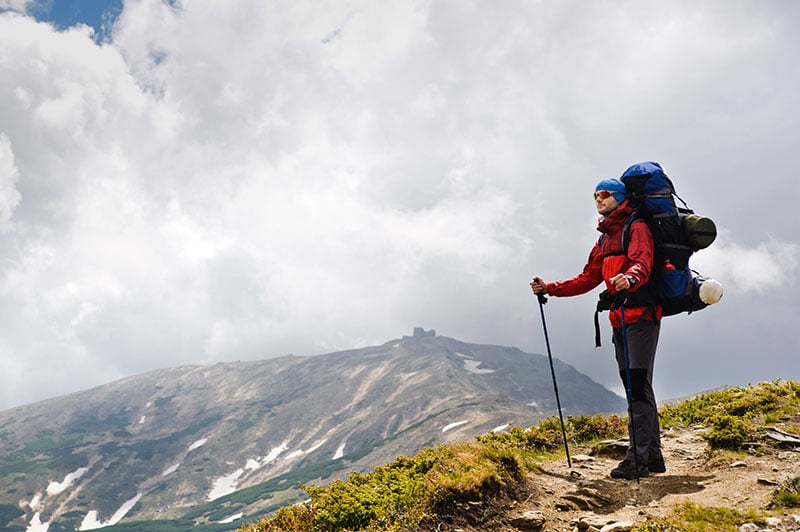Planning a backpacking trip and looking for ways to maximize the available space in your pack?
One easy way to free up more space in your backpack is to attach your sleeping bag to the exterior of the pack, instead of stuffing it inside with the rest of your gear.
As you might have guessed, there’s more than one way to secure a sleeping back to your backpack.
Wanna know which way is the best?
Truth is they’re all good and whichever one works best for your and your gear is the ideal attachment option for you.
So, keep reading for the ways you can accomplish this.
1. Use The Straps And Loops
Hands down the easiest way to get this done, is if your backpack has loops or straps hanging down from the back panel.
These are the perfect way to secure your sleeping bag to the pack.
All you gotta do it put the sleeping bag in it’s stuff sack and then secure and tighten it in place via the pack’s loops or straps.
Simples, eh?
Unfortunately it’s not to simple for a lot of backpackers because not all packs have this feature.
You can always upgrade your gear to a backpack that does have this feature.
Or, you can use one of the other methods listed on this page.
2. Use The Lid (Internal Frame Backpacks)
Got yourself a backpack with an internal frame that you’re taking out on your outdoor adventure?
Well, as you know the style of this type of pack is basically a long cylindrical gear chamber with the tightening strings/straps at the top.
I actually had an old backpack like this back when I was younger and it was really a pain to use because finding stuff in it was a real challenge.
Especially if it is was something small that got buried by other things.
But I tell you what, those tightening strings/straps at the top of the backpack are durable as hell.
That’s why you can use them to secure your sleeping bag by the lid.
So, once your pack is fully loaded you place your sleeping bag on top of everything under the lid and tie it up in place with the top tightening straps/strings.
Then, you just flip the lid over top of it to cover it.
Tip: There will be a gap between the lid and the rest of your backpack, which can lead to a moisture problem. A nylon rain cover fixes this problem.
3. Use The Tie Points (External Frame)
If you’re going to be wearing a backpack with an external frame, then you can take advantage of the frame’s tie points to secure your sleeping bag to the pack.
Just use the straps you see hanging by the tie points to securely attach the sleeping bag to the backpack.
It’s important that you attach the sleeping bag as close to the pack as possible so that it’s not swinging around as you walk.
Not only will a swinging sleeping bag get annoying after a while, it also mess up your stride and the imbalance results in some body aches and pain.
So, tighten it up real snug-like when you’re using the tie points and straps.
4. Use The Side Compression Buckles
If you don’t have a backpack with the features listed above, then I bet you’ve got one with those side compression buckles or straps.
I’ve got an old Tortuga backpack that I use for travel that has these and, in a pinch, you can use them to secure gear to the outside of the pack.
Now, you’ll have to improvise a bit here to actually secure the sleeping bag to the side of your backpack.
You likely won’t have enough room to put it under those straps/buckles.
So, that means you need to MacGyver it.
You can do this with pretty much anything that you can tighten – zip-ties, bungee cords, rope, etc.
However you end up securing the sleeping bag, make sure that you’re evenly distributing the weight so that you don’t end up injured or fatigued by the time you get to the camp site.
Should You Just Pack It Inside The Backpack?

You might be tempted to just stuff the sleeping bag inside the backpack, so should you do it?
No, don’t pack the sleeping bag inside the backpack if you want to maximize available space.
Sleeping bags take up a lot of space – space that you can use for food or other gear.
The only advantage of putting the sleeping bag in the pack is that it protects it from the elements, like rain.
However, if you’ve got a good nylon rain cover for the backpack, then you can probably cover the sleeping bag even with it on the exterior if the pack.
Granted, if you have other gear that is already wet, then you may want to put the sleeping bag inside so that the wet gear can be secured to the outside of the pack to dry out.
Tip: Internal frame backpacks have straps at the bottom to help with additional compression.
Should I Attach It To The Bottom Or Top?
You might be wondering which is better – tying your sleeping bag to the top of the backpack or to the bottom of it?
The answer is – it depends on what you prefer.
It also depends on what features your backpack has – you may only have one option for securing the sleeping bag in place.
Personally, I think attaching the sleeping bag to the top of the backpack is the better option.
This way, when you take off the backpack and put it down on the ground, the sleeping bag is not touching the possibly damp ground.
Having the sleeping bag high up on the top of the backpack also means that low hanging branches and briers won’t snag it and possibly damage it.
Additionally, placing the weight of the bag higher up on the pack is better for preventing and reducing lower back pain from carrying that load.
How To Tell If You’ve Got An External Frame or Internal Frame?
If you’re relatively new to backpacking, then you might not be that familiar with the typical gear.
In fact, you may know that your backpack has a frame but you’re just not certain if it’s considered to be an internal one or an external one.
Let us help with that.
Generally speaking, backpacks with internal frames have a lid and are slimmer and more lightweight.
Alternatively backpacks with an external frame weight a bit more, have a boxier shape, and can hold more gear.
